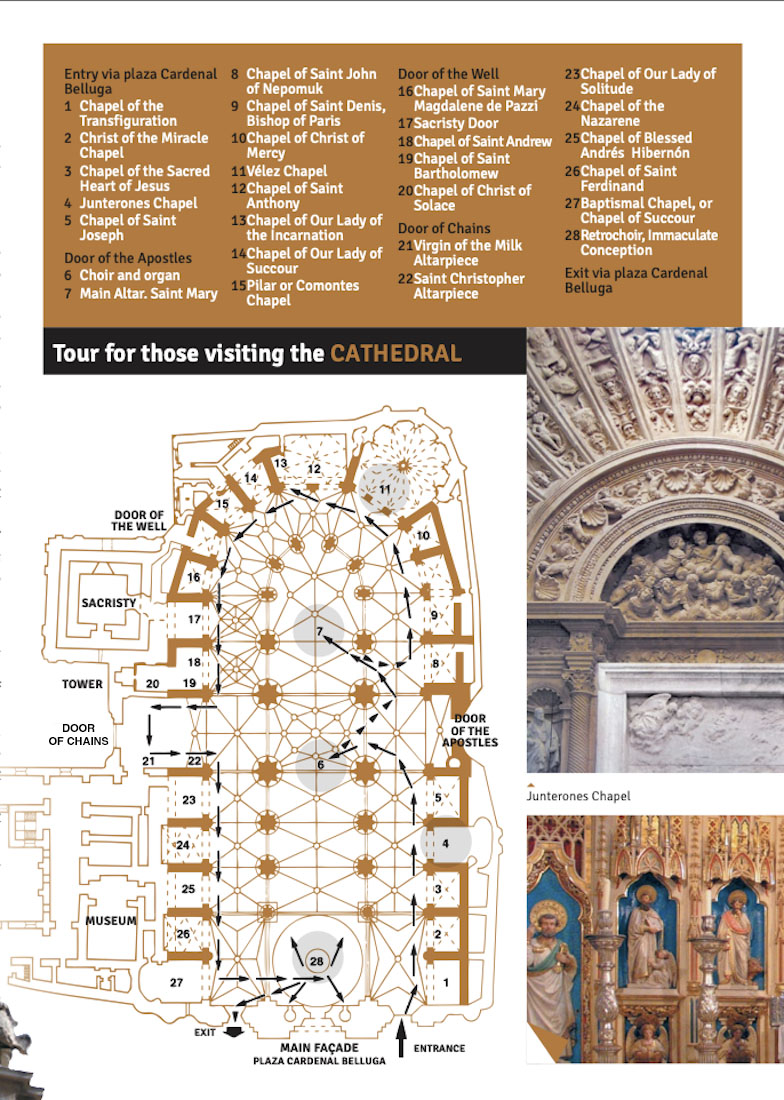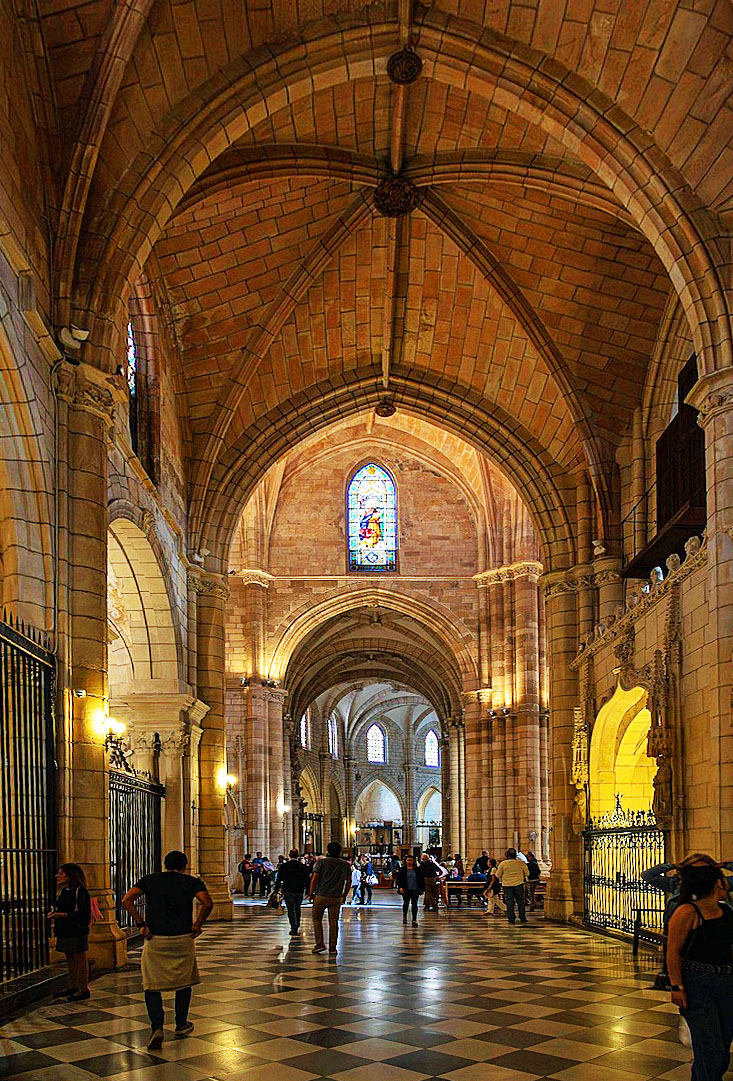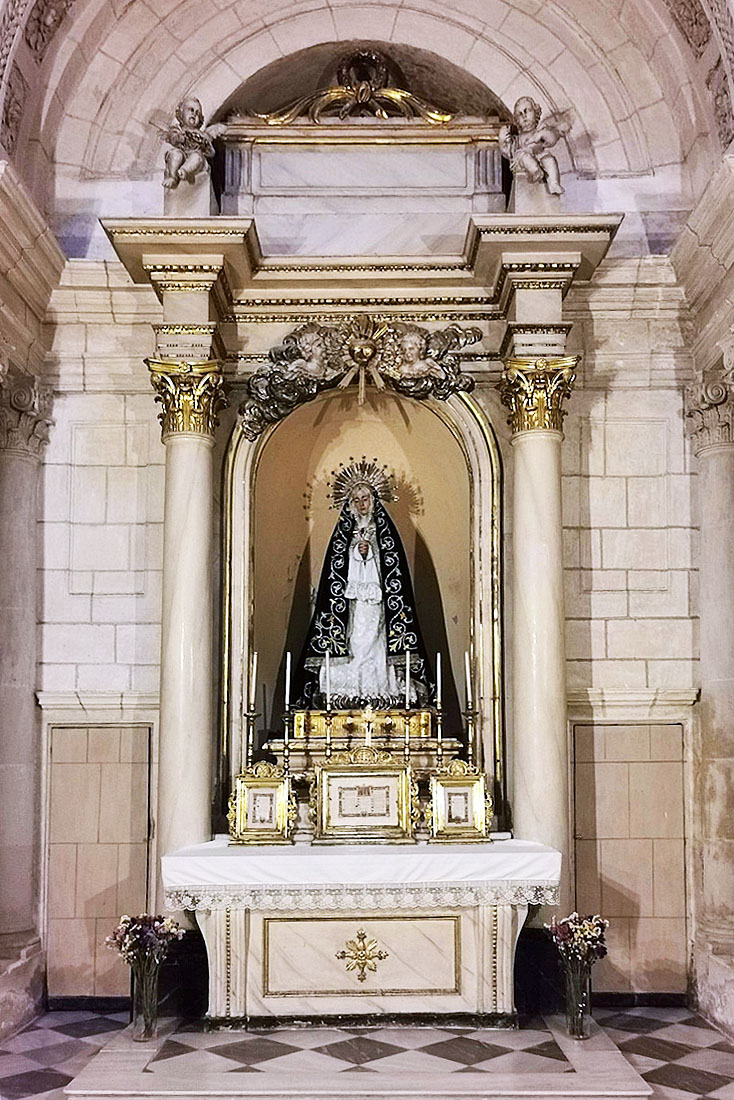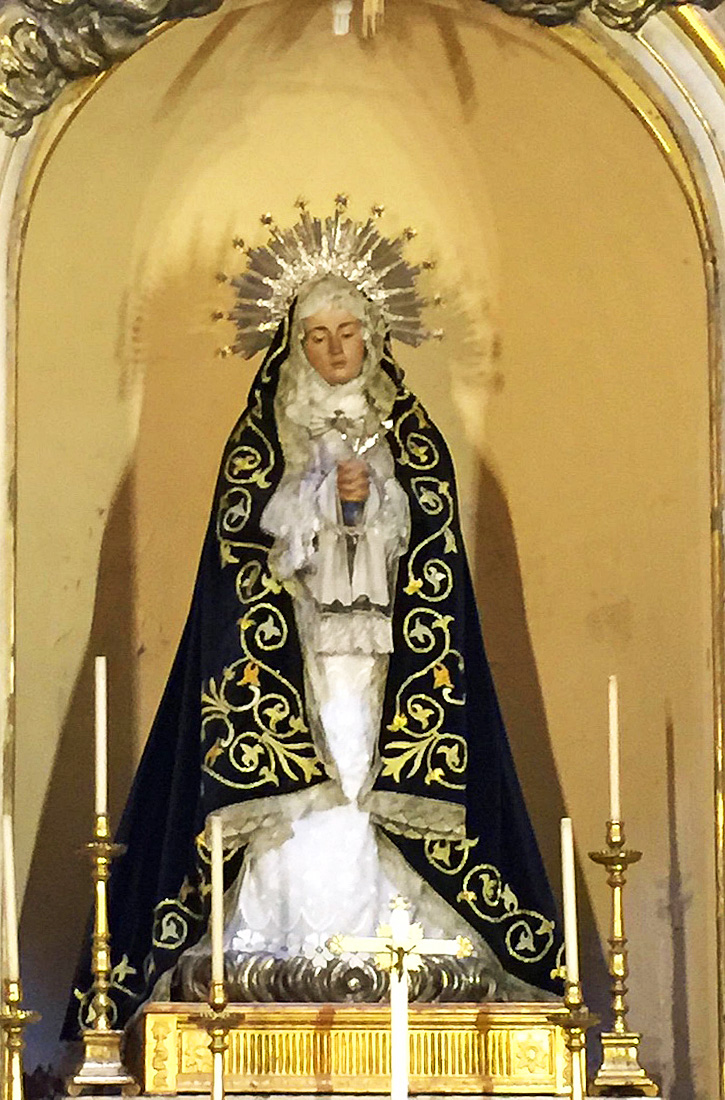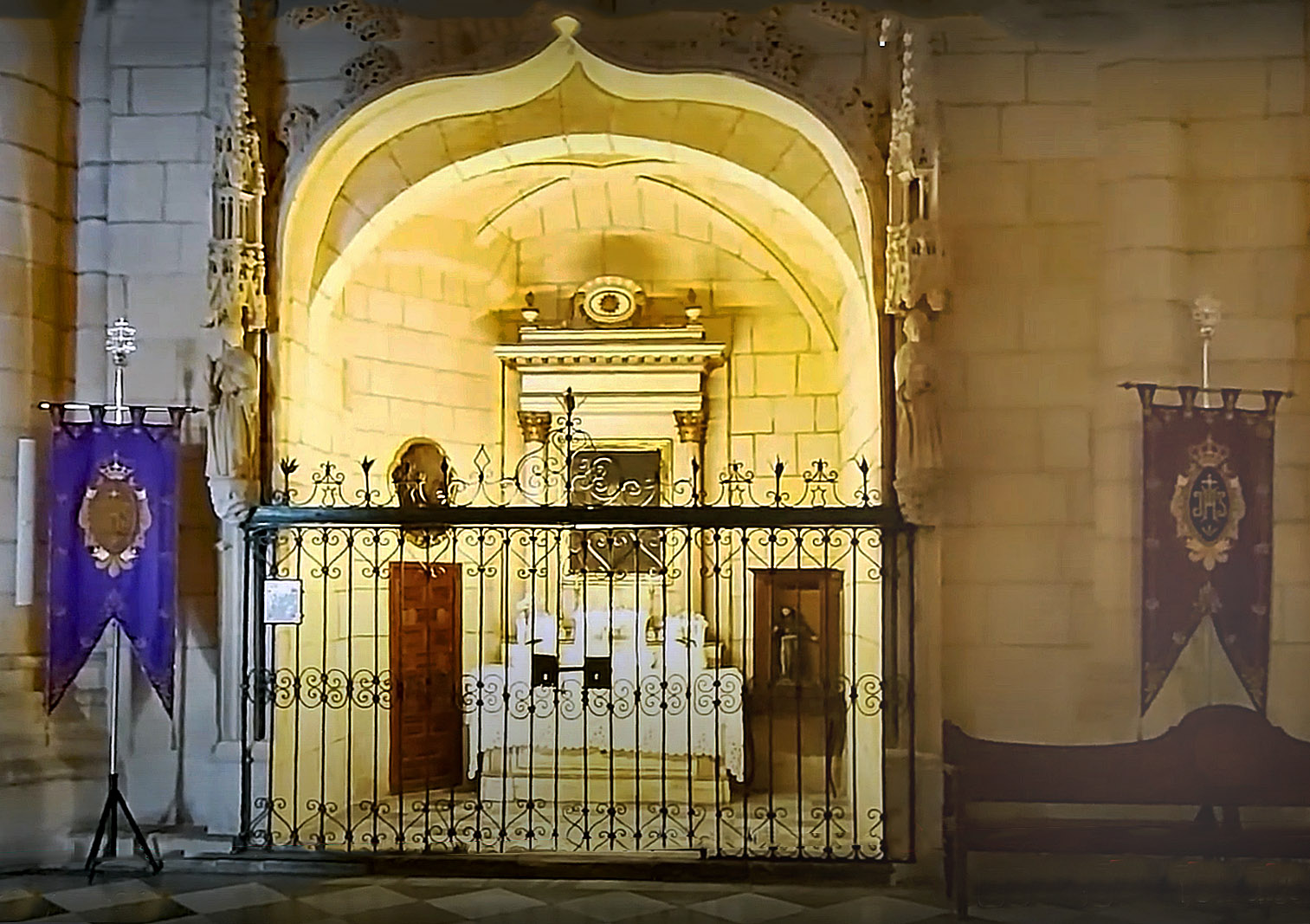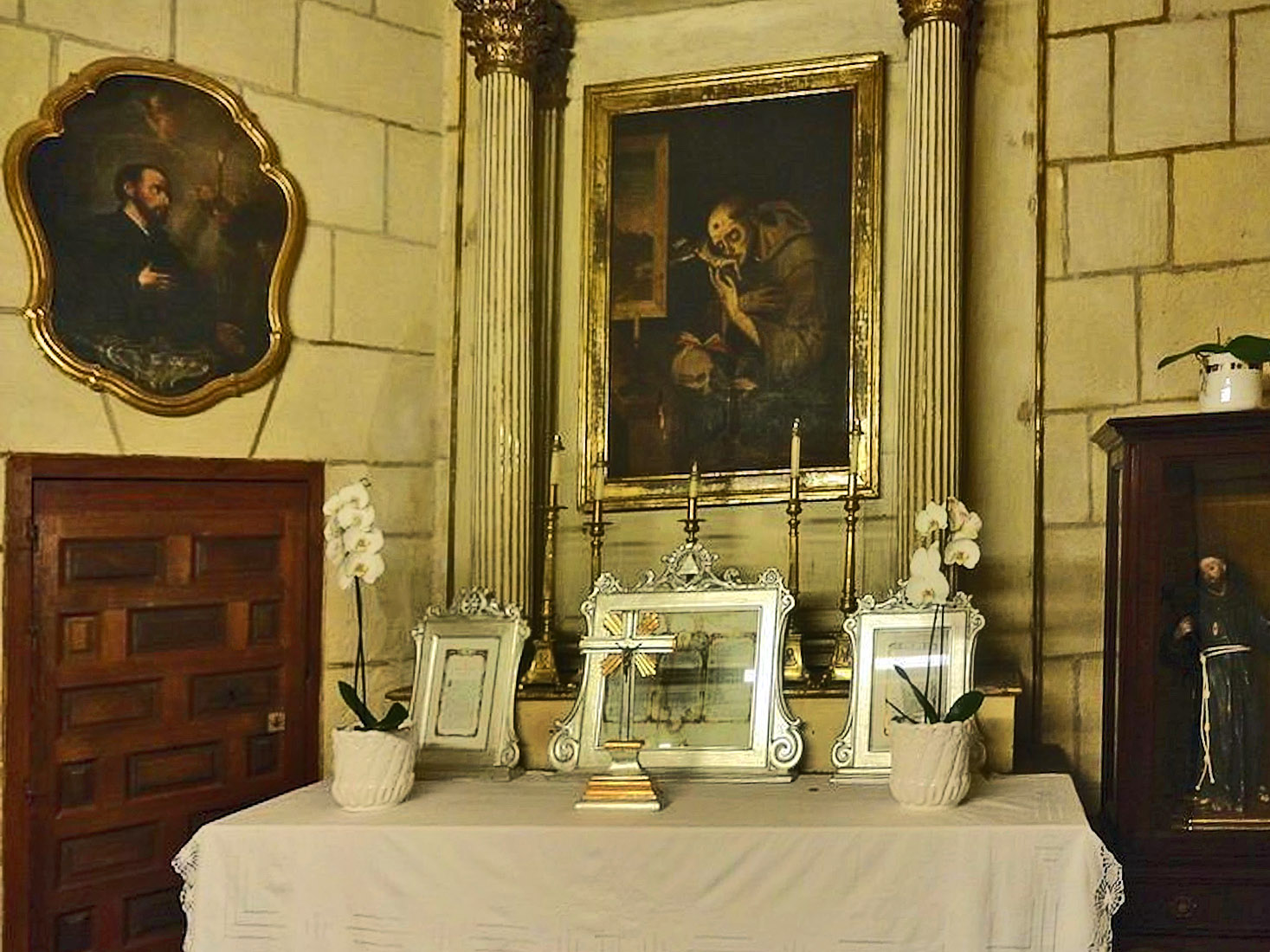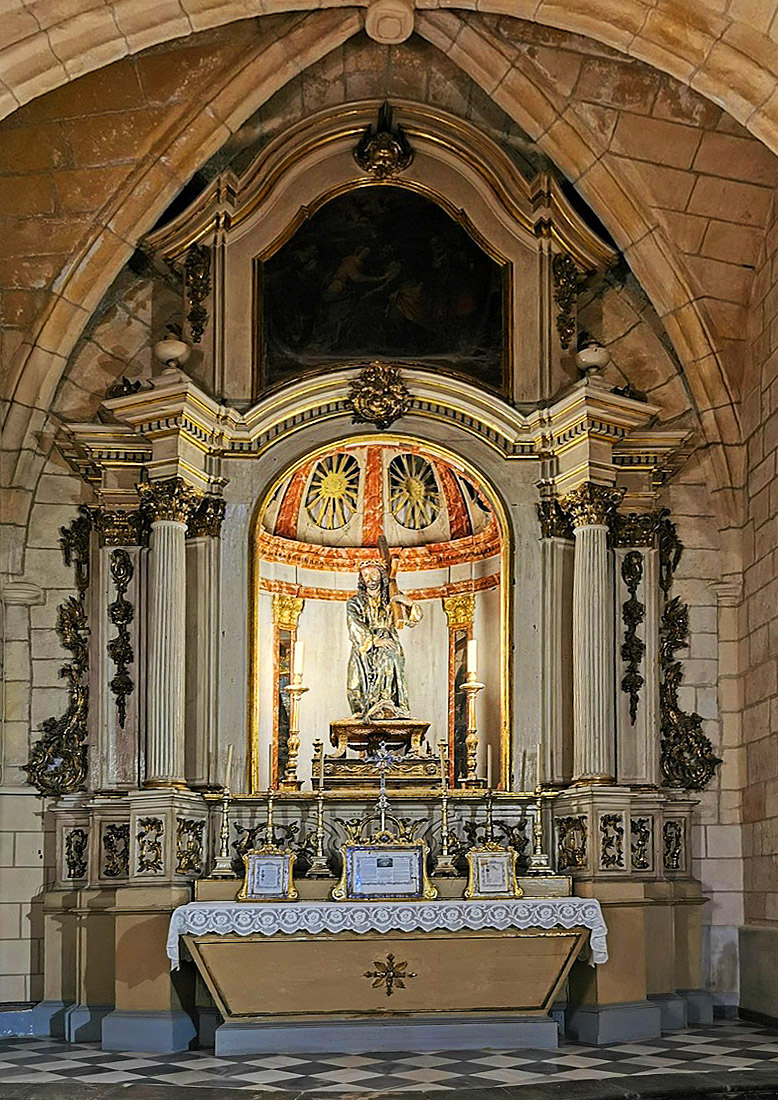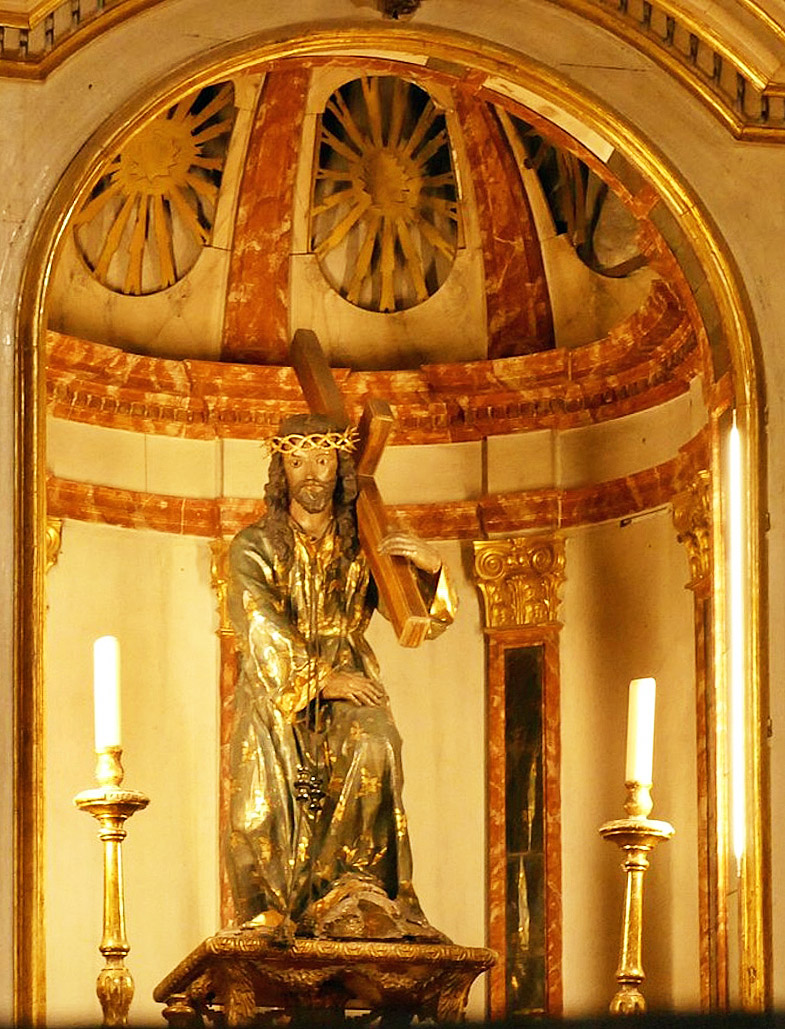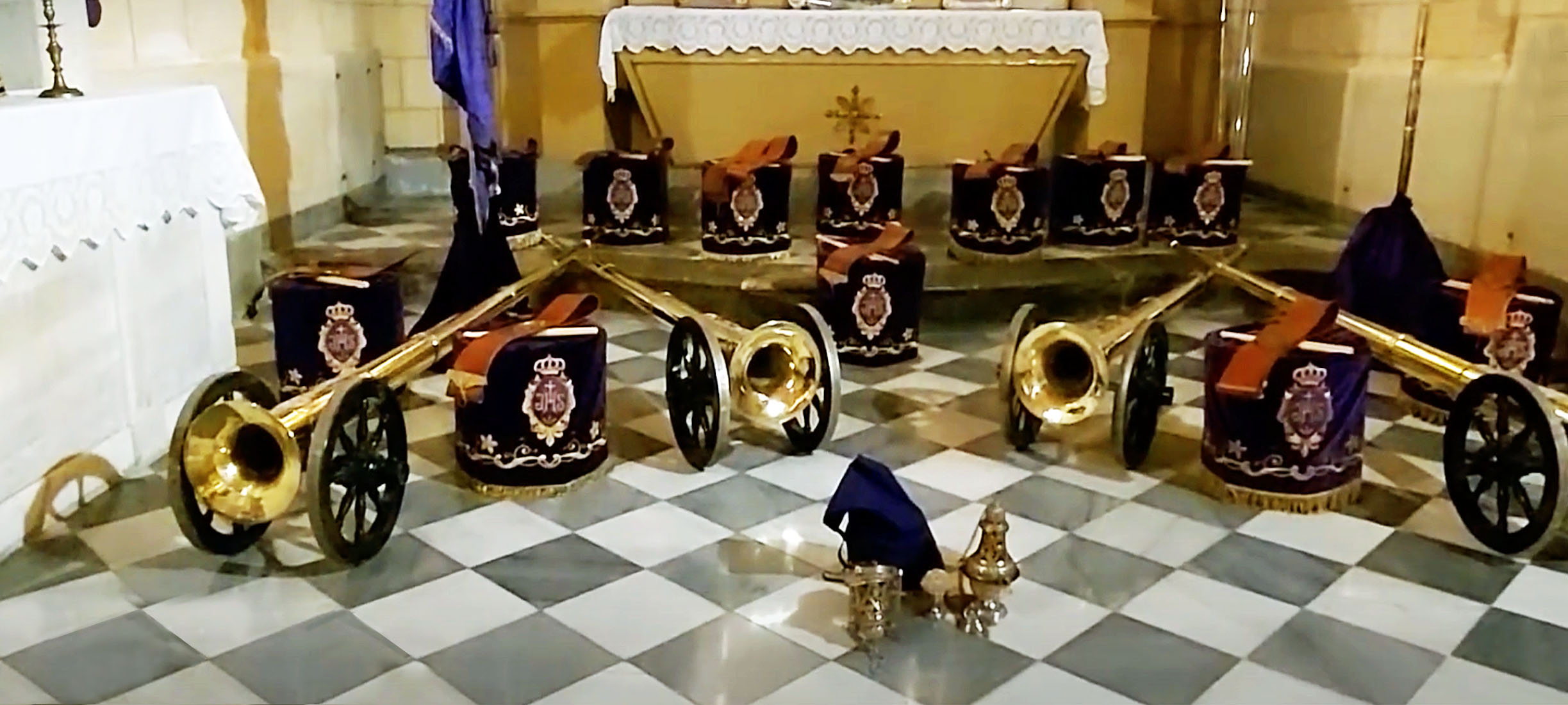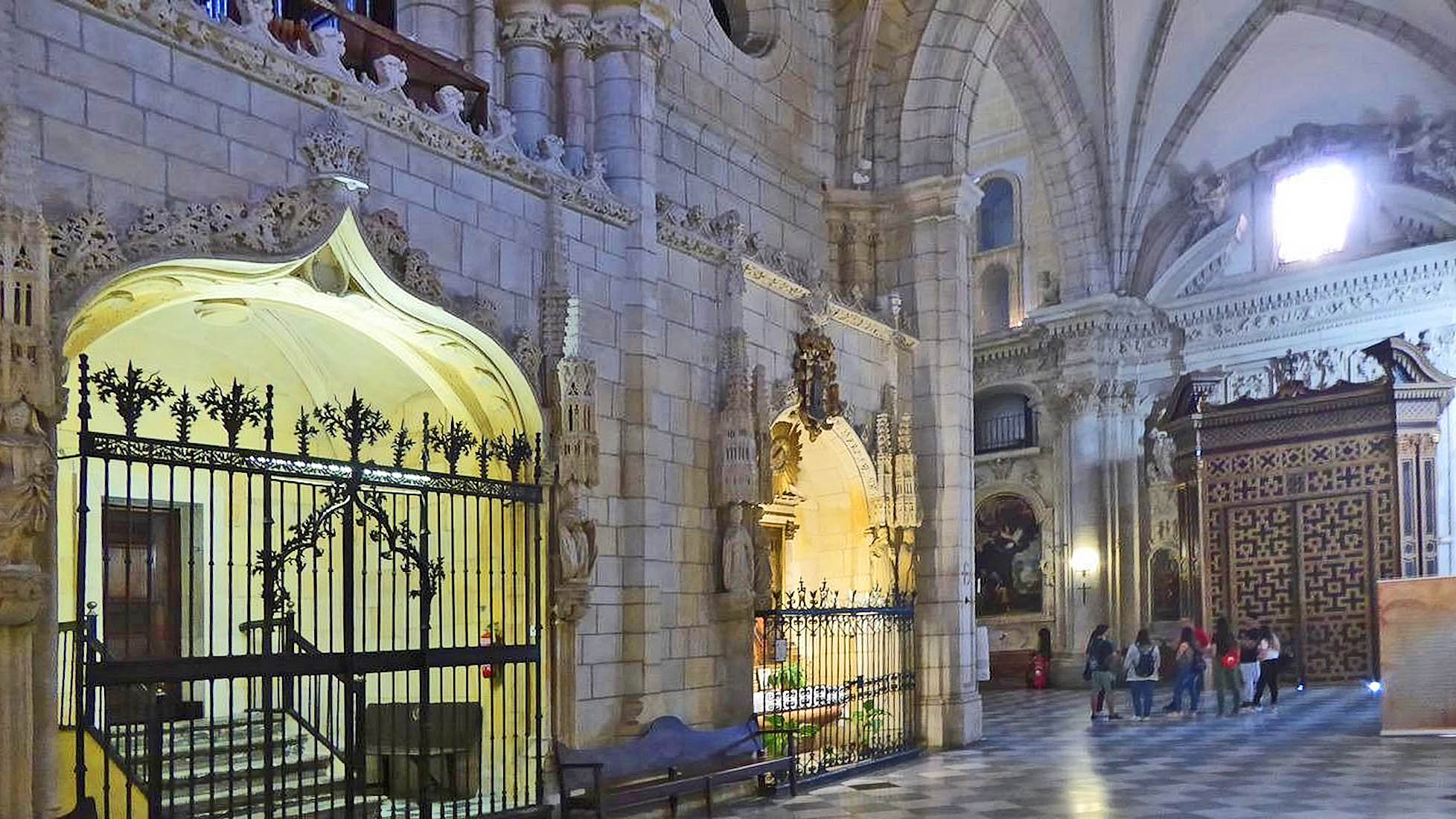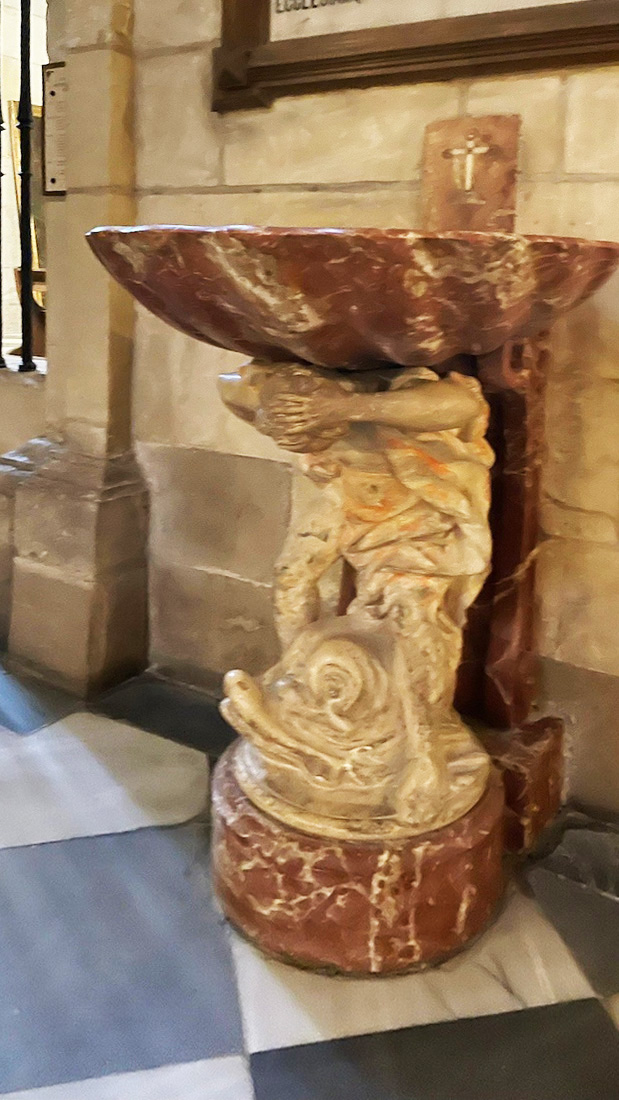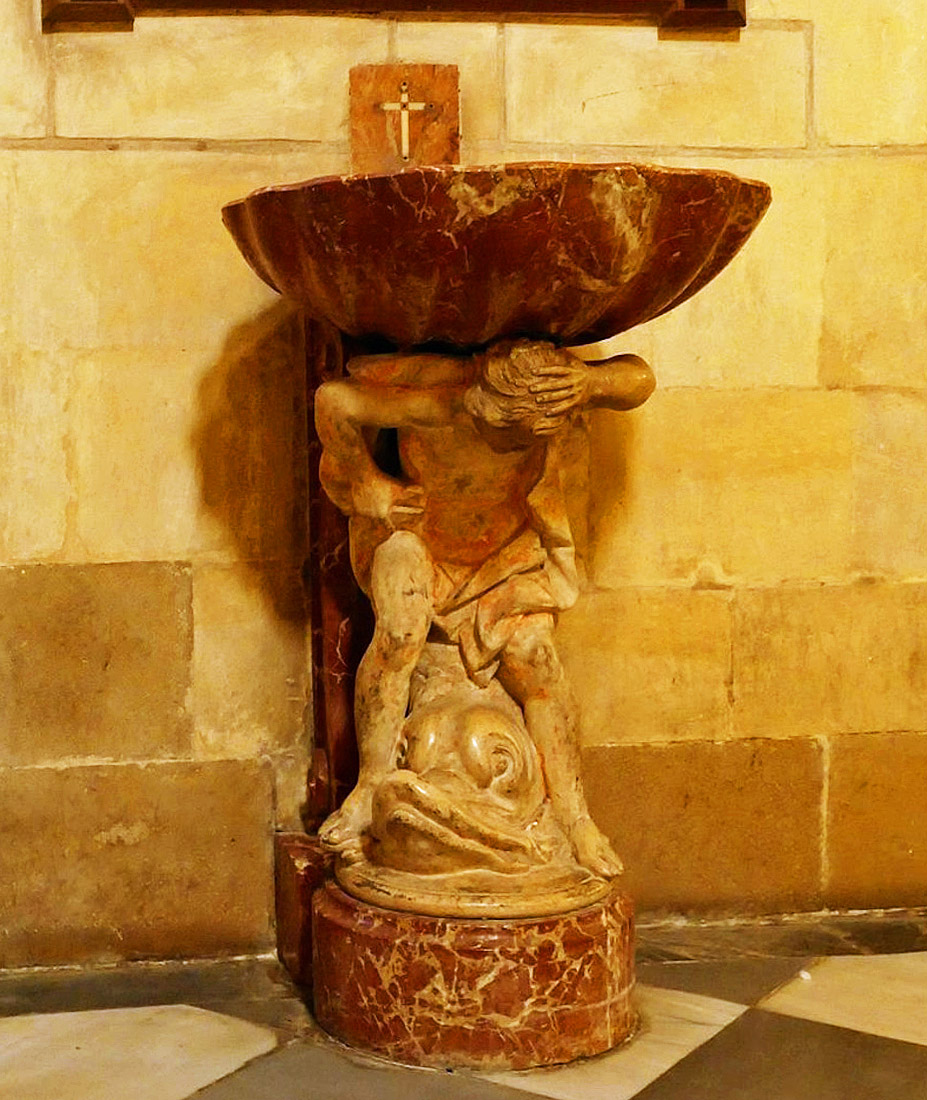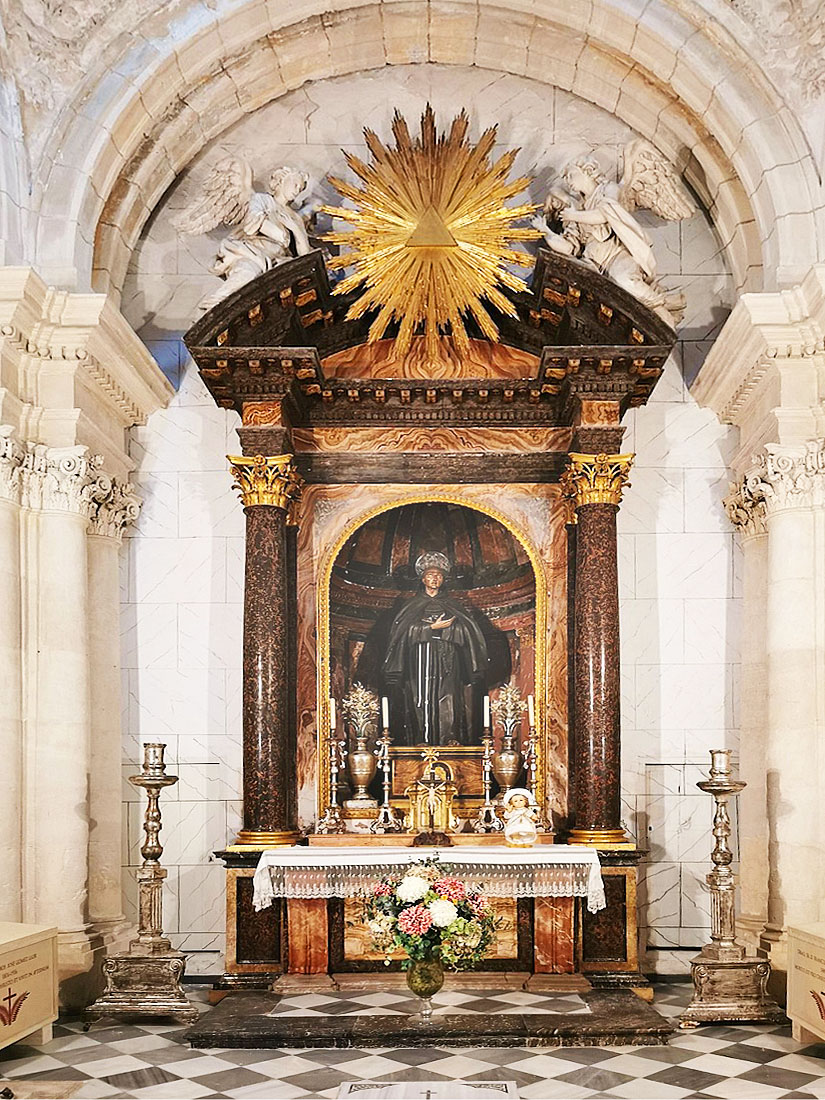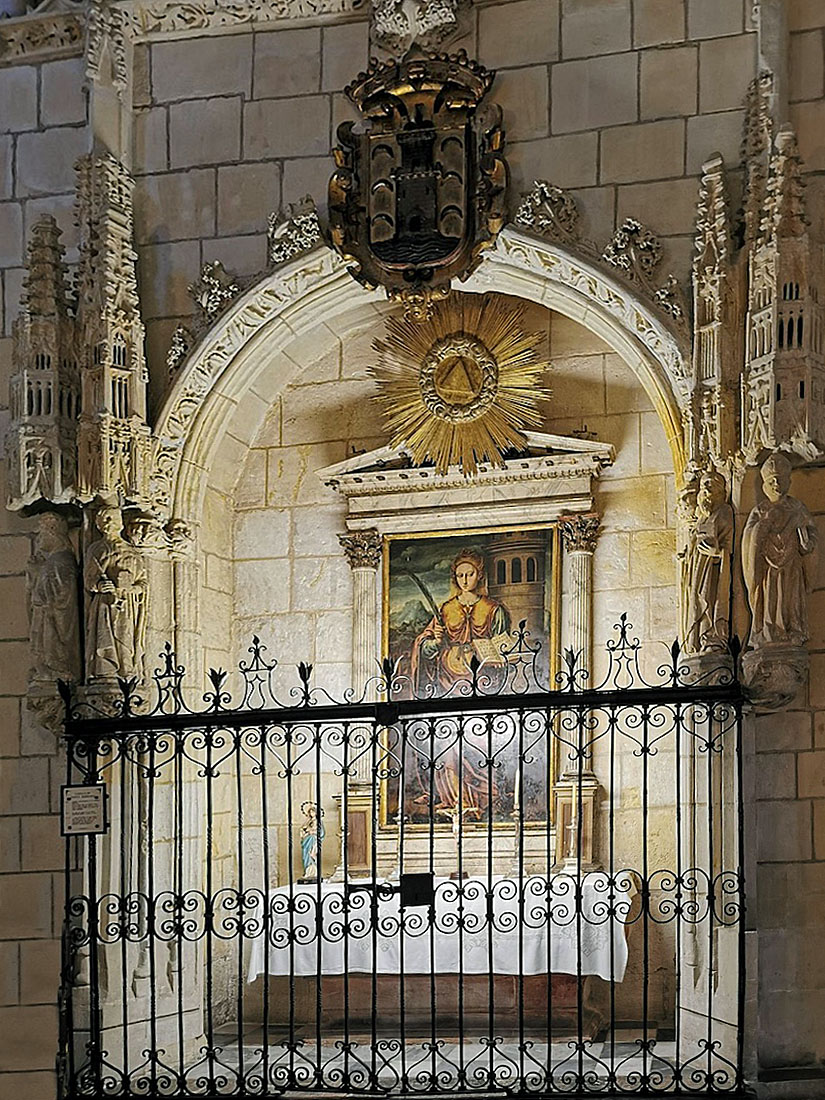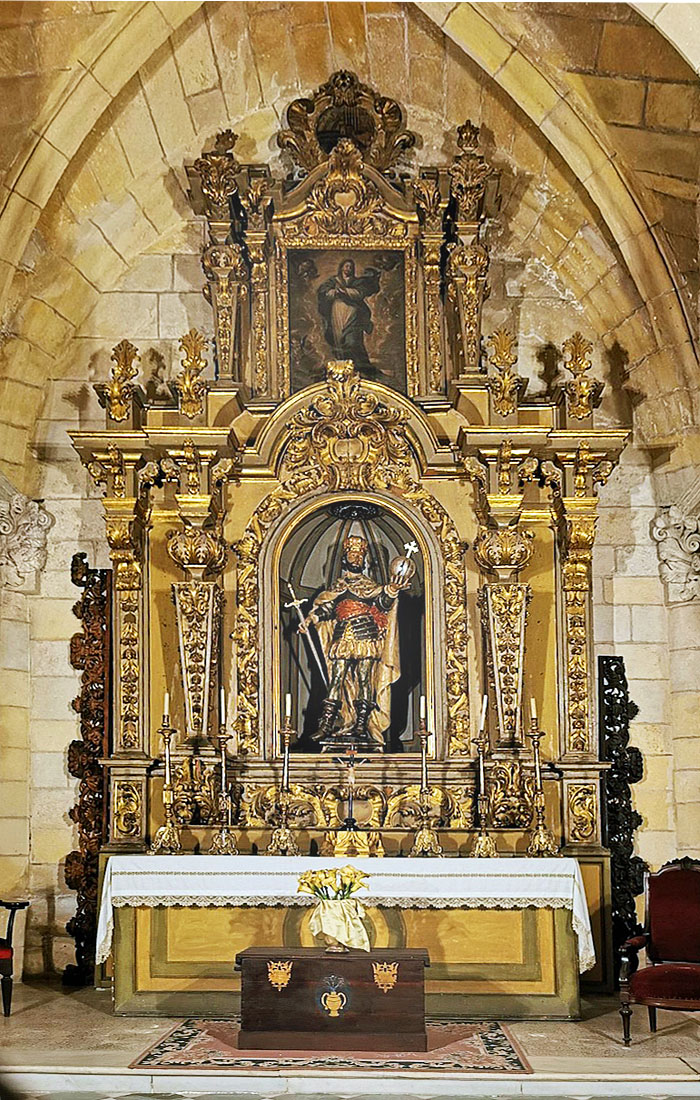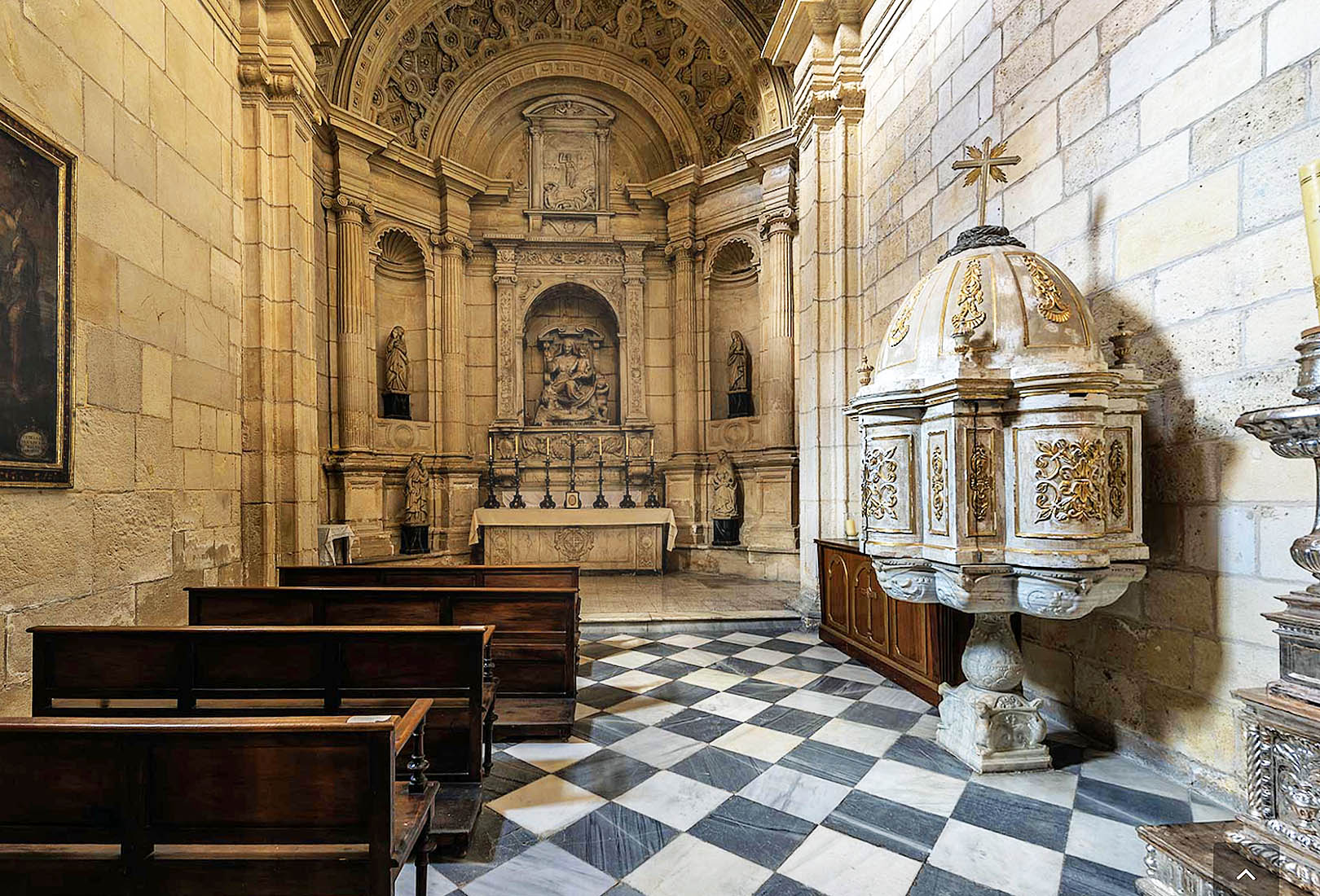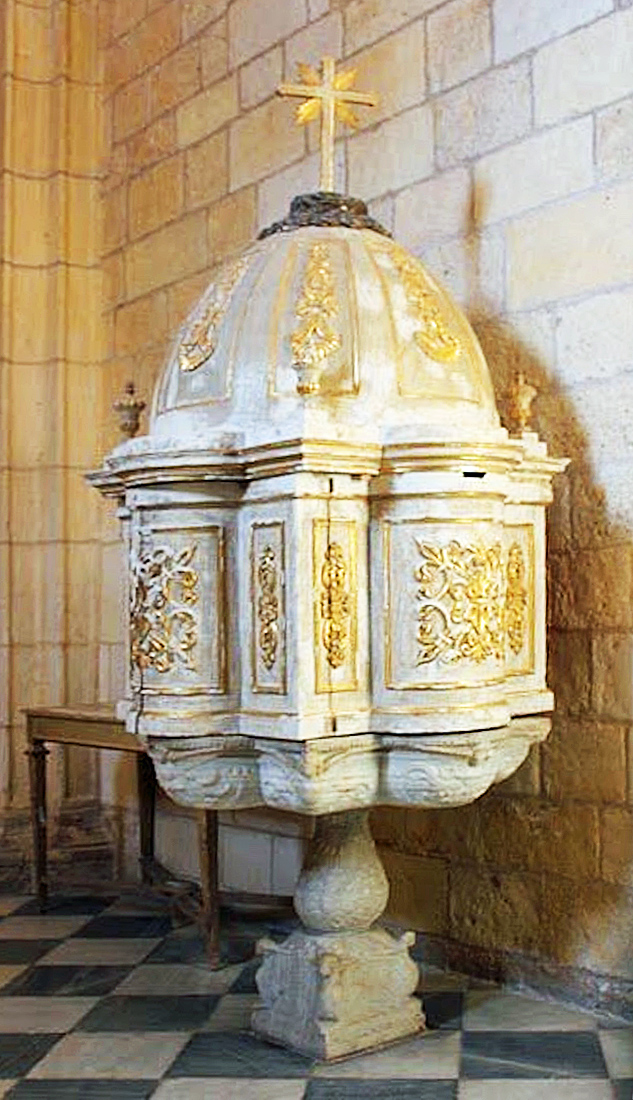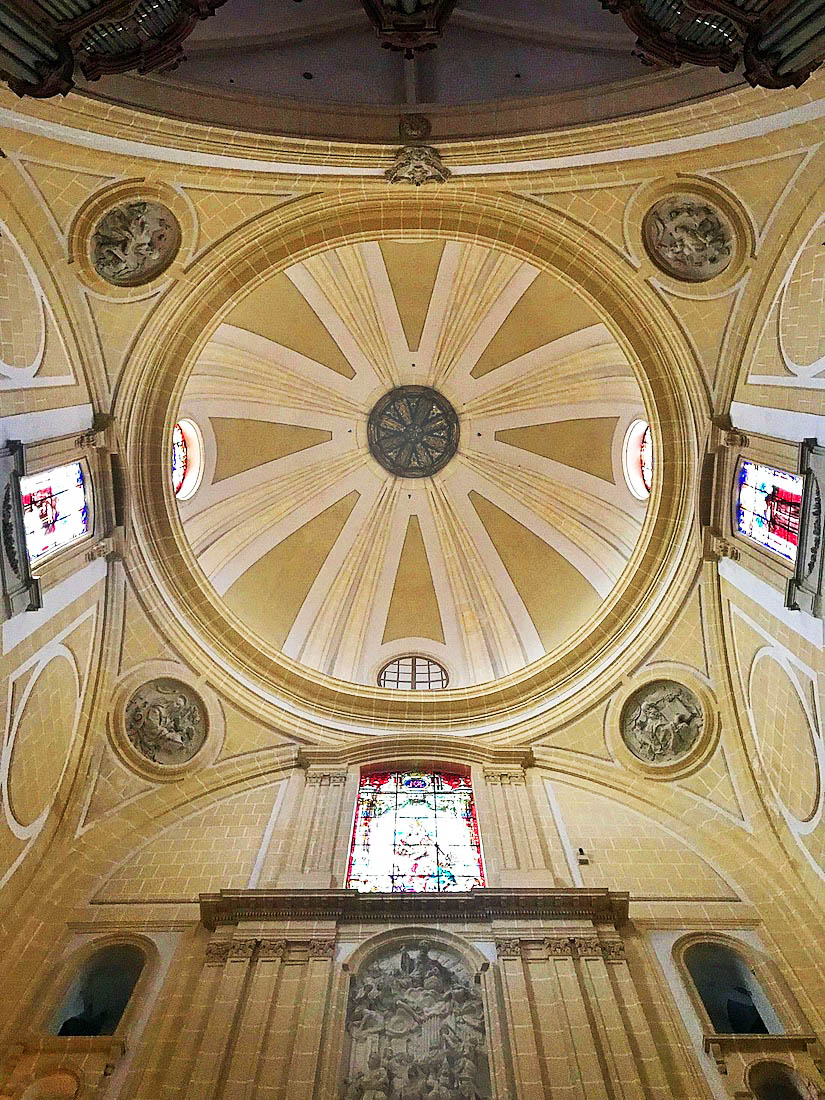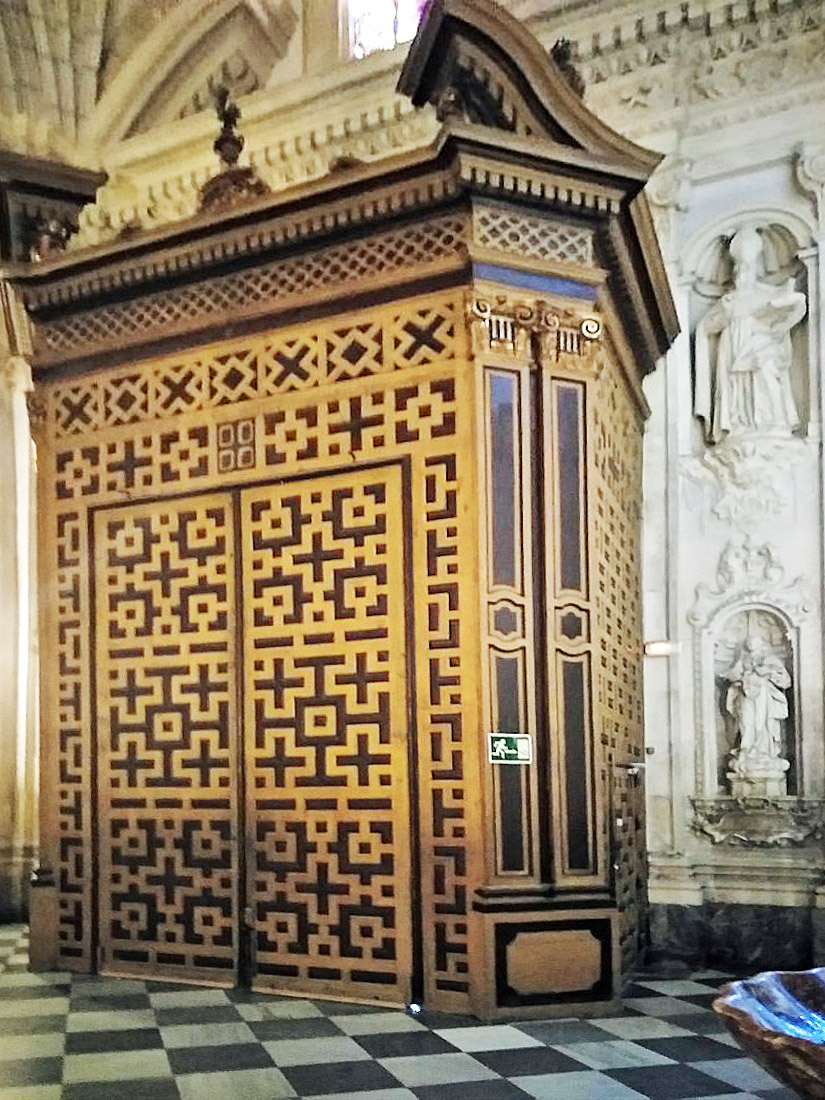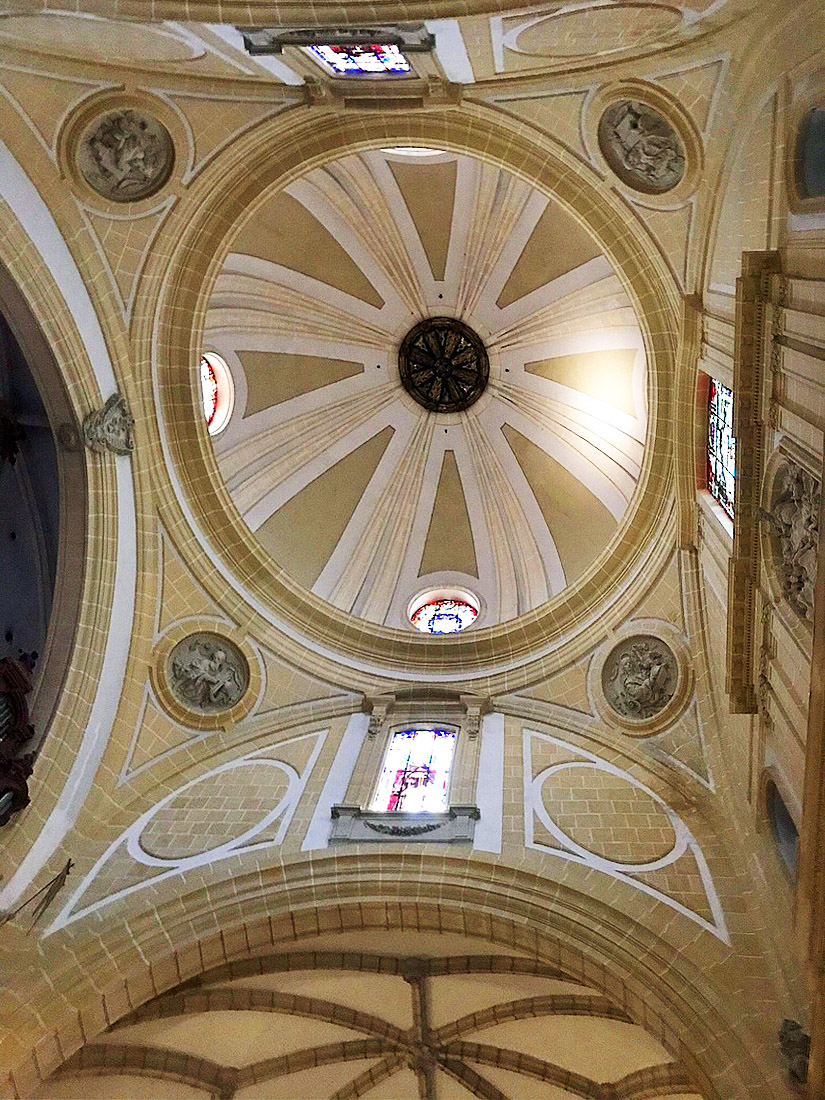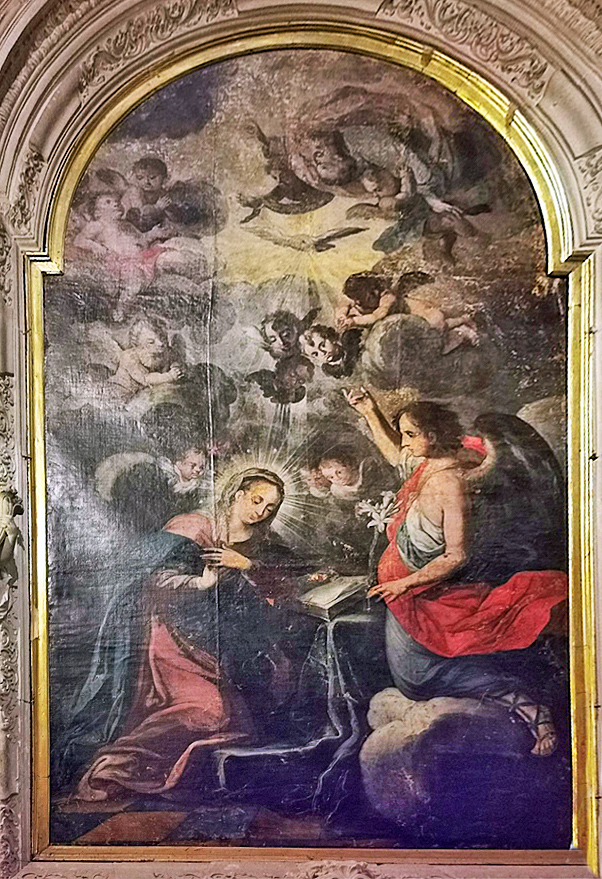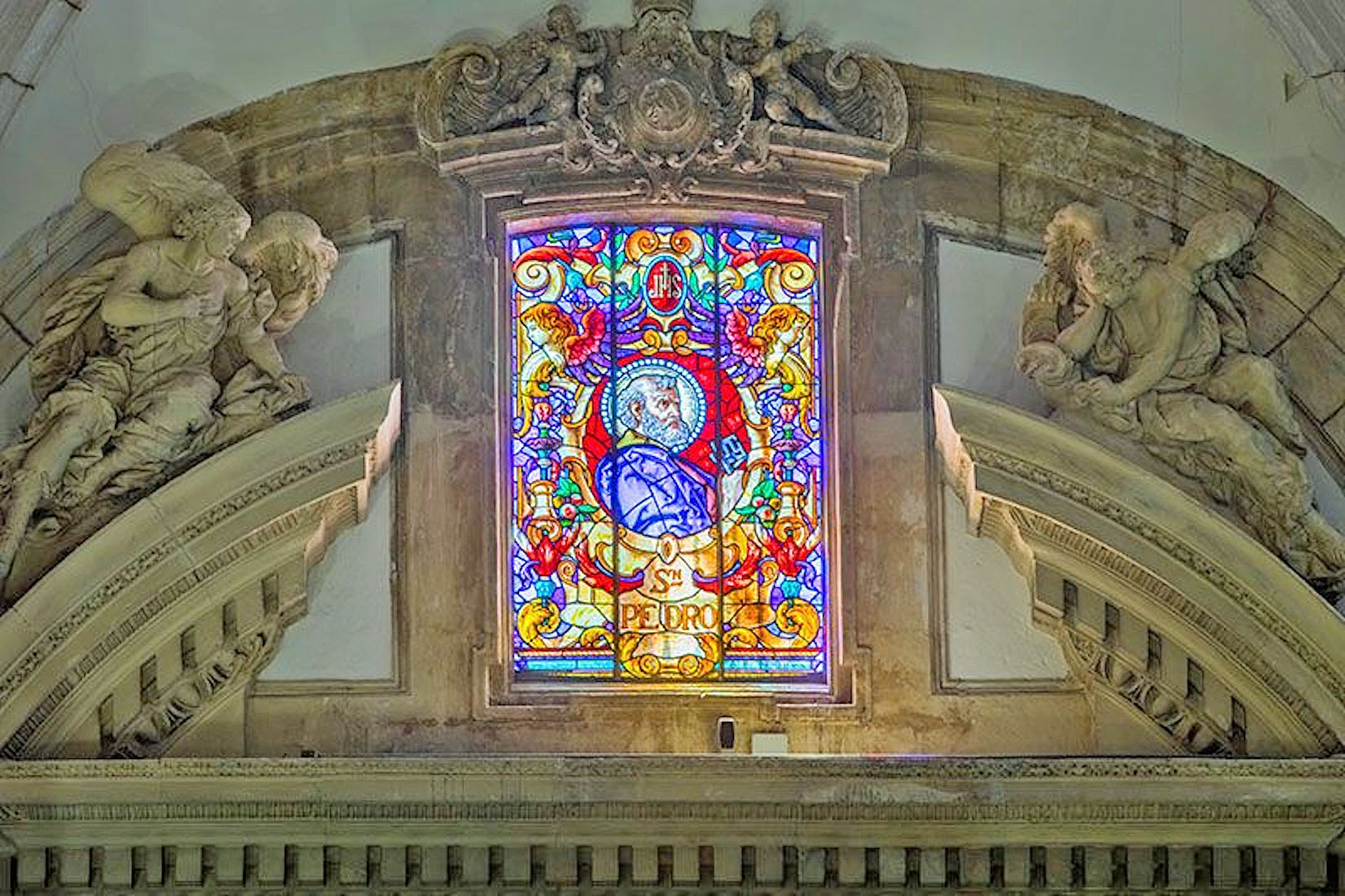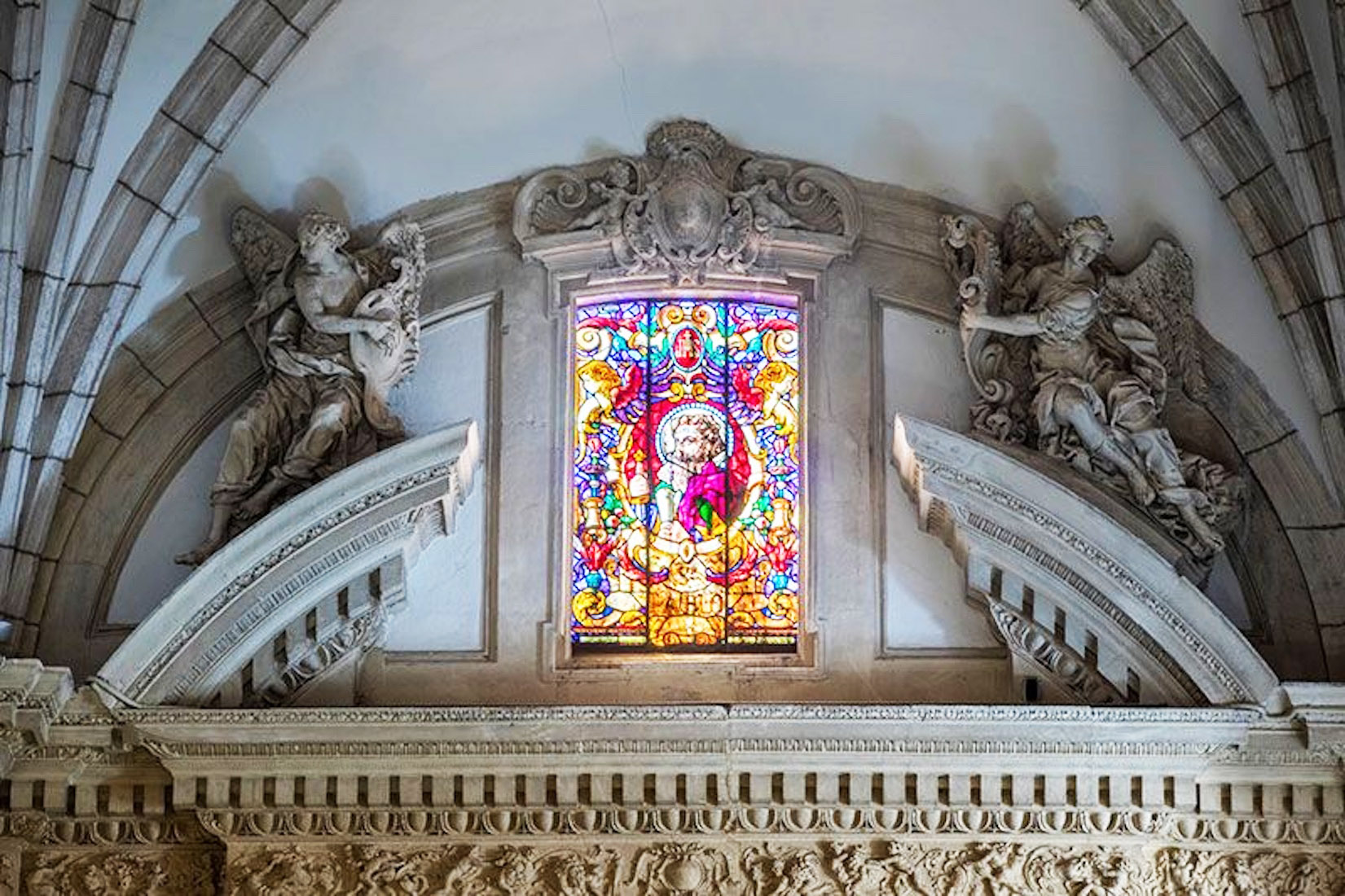21. VIRGIN OF THE MILK ALTARPIECE TA TA
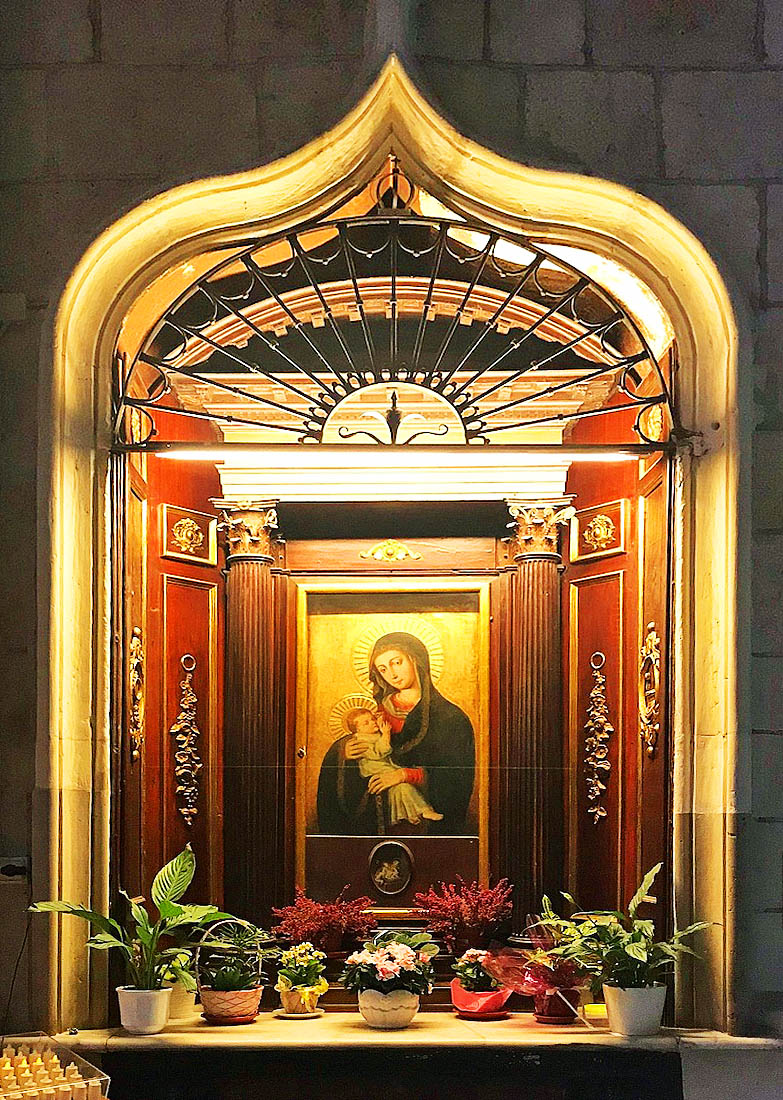
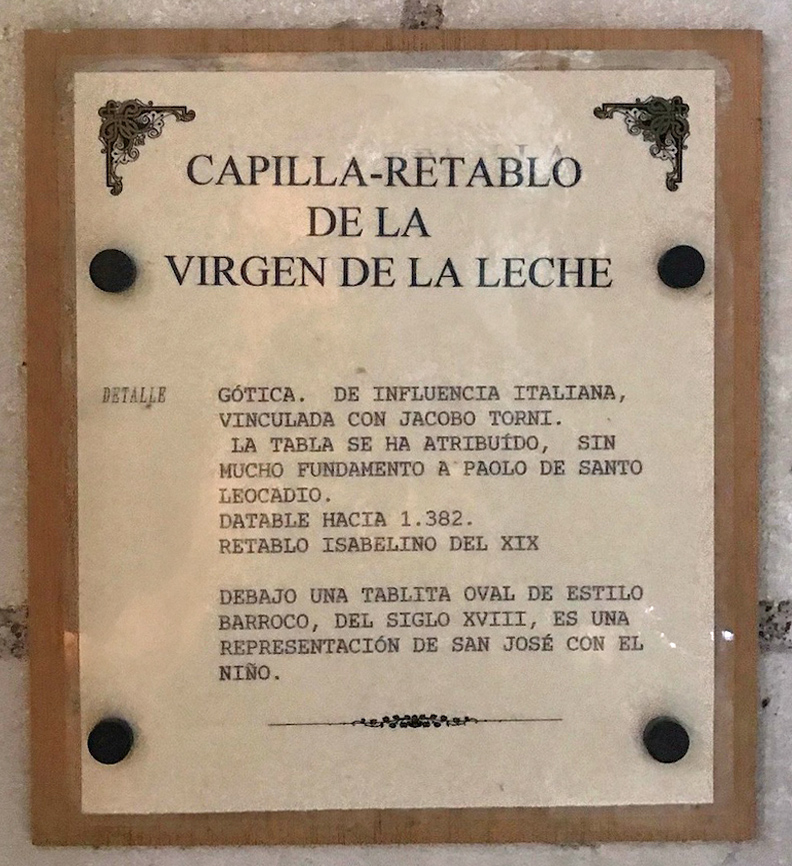
Just by the entrance to the museum is this Virgin of the Milk altarpiece. There seems to be a local fascination with the feeding of the baby Jesus! At right is an explanatory sign – in Spanish. There are many such signs placed around the Cathedral. [Photo1 Credit:Luis E ] [Photo Credit: MC ] INDEX
22. ST CHRISTOPHER ALTARPIECE TA
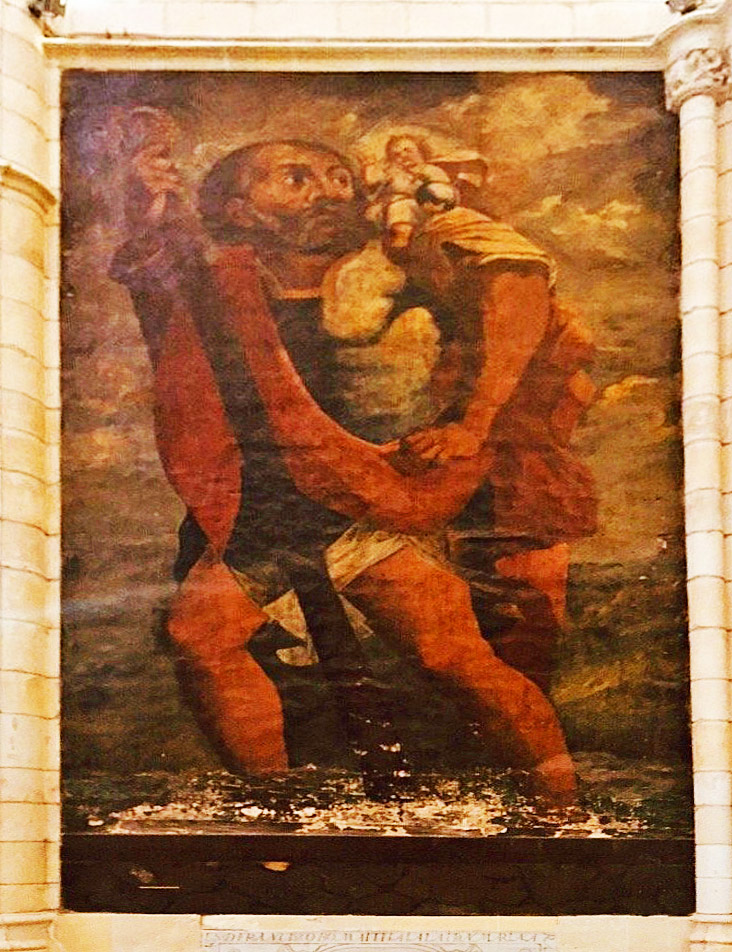
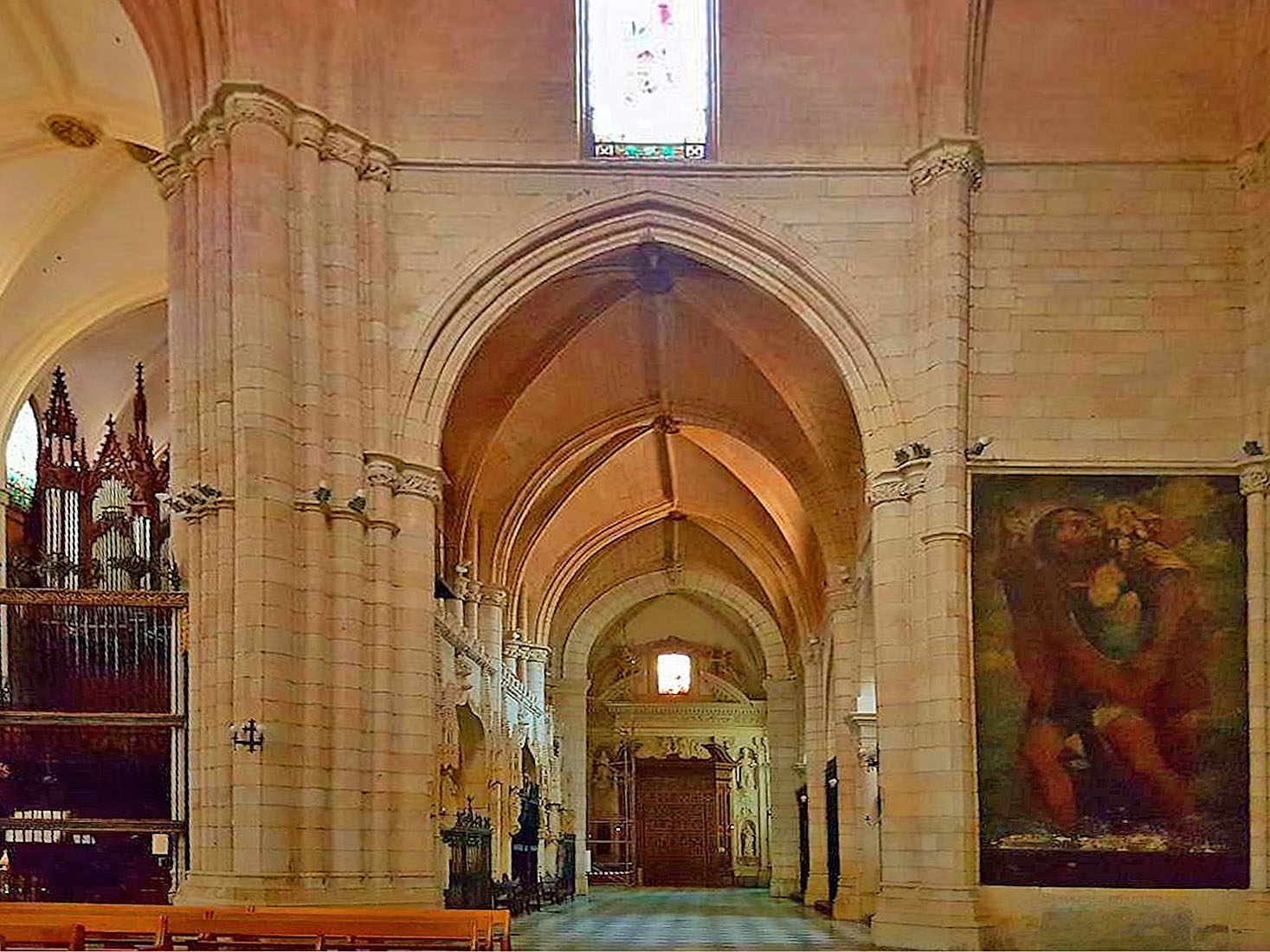
We next come to the St Christopher altarpiece. According to tradition, St Christopher was a martyr who died during the reign of one of the early Roman emperors. The most famous legend connected to the saint recounts that after converting to Christianity, he devoted his life to carrying travelers across a river. One day he carried an unknown young boy across the river after which the boy revealed himself as Christ. Because of his help to travelers, he became the patron saint of travelers. In the iconography of the Western Church, the saint is often depicted (as here) as a giant with a staff carrying the infant Jesus across a river on his shoulders. •• The second photo shows our present location at the corner of the North transept and the North aisle. [Photo1 Credit: Candi ] [Photo2 Credit: Albert S ]
22 – 23. FROM AND TO ... TA TA
To help get our bearings, here we are in the North aisle, looking back to the curved ambulatory where we have been, and then in a Westerly direction where we are going next. We notice there are chapels on both sides, and the large exit door which is the Northern-most of the three West doors. Just to the right of this door we can see a carved stoup (containing holy water): we shall look at this more closely shortly. [Photo1 Credit: MarcusHurley ] [Photo Credit: Robert A ]
23. CHAPEL OF OUR LADY OF SOLITUDE TA TA
On our right, just around the corner from St Christopher, is Chapel #23, the Chapel of Our Lady of Solitude. The statue of the Virgin Mary is positioned in an ornate, arched alcove with golden accents, flanked by columns and cherub figures. The statue itself is dressed in a black and white robe, with candles and decorative elements surrounding it. [Photo1 Credit: Vadim ] [Photo2 Credit: Begoaisa ]
23 – 24. UNNAMED CHAPEL SS TA
This Chapel is directly opposite Chapel #23. It does not appear on the Cathedral Plan, and I can find no reference which will give the name. The small Chapel has two paintings and an altar with a cross, candles, and various other artefacts. [Photo2 Credit: Pierre G ]
24. CHAPEL OF THE NAZARENE TA TA
Chapel #24 is Chapel of the Nazarene, and has an imposing statue of Christ carrying his cross. From time to time the chapels are chosen for special displays. This collection of trumpets and drums would be used in religious processions associated with the Cathedral. [Photo1 Credit: Vadim ] [Photo2 Credit: naxo1968 ]
24 – 25. STEPS AND STOUP SS TA TA
The central ‘chapel’ on the inner wall of this aisle has steps leading up to the organ – the image of the corresponding space on the Southern aisle. •• Further down this aisle, as we have noted, is a stoup for holy water. The stoup has a red marble base and bowl, and the bowl is supported by the statue of a man in cream marble, with a fish at his feet. The basin is shell-shaped and has a small cross engraved on the inside. [Photo2 Credit: mrskrun ] [Photo Credit: naxos1968 ]
25. CHAPEL OF THE BLESSED ANDRÉS HIBERNÓN TA
The next Chapel #25 features a statue of the Blessed Andrés Hibernón. Andrew was the descendant of an old Spanish noble family which had, however, been reduced to poverty through adverse circumstances. He was born in Murcia in the year 1534. His story can be found here. [Photo Credit: Vadim ]
25 – 26. CHAPEL OF SAINT BARBARA TA TA
Opposite Chapel #25 is the Chapel of St Barbara – the last Chapel along this side of the aisle. St Barbara who appears here is probably more famous because of the Saint Barbara Castle in Alicante. St Barbara was an early Christian Greek saint and martyr. She is the patron saint of armourers, artillerymen, military engineers and others who work with explosives. She was tortured for her faith, but her wounds miraculously healed overnight. Finally her father beheaded her, but he was then killed by a bolt of lightning. Good bed time reading! [Photos Credit: Vadim ]
26. CHAPEL OF SAINT FERDINAND TA
The next Chapel on the North side of this aisle is the Chapel of St Ferdinand. The altarpiece itself is highly ornate, featuring gilded details and sculptures, with a central figure of San Fernando III holding a sword and orb. San Fernando III, also known as Saint Ferdinand III, was the King of Castile and León in the 13th century. [Photo Credit: Vadim ]
27. BAPTISMAL CHAPEL TA (x3)
We are nearing the end of our exploration of Murcia Cathedral This is the last of the side chapels. The Baptistery Chapel was built in 1546. From then until 1908, the sacrament of baptism was held in this Chapel. The Chapel is designed in a Baroque style with Italian influences, evident in the layout and the use of polychrome marble. [Photo1 Credit: Management ] [Photo2 Credit: Pierre G ] [Photo Credit: Luis E ]
27 – 28. WEST DOOR NORTH TA
This is a detailed view of one of the carved wooden doors of the Cathedral. The door features intricate geometric patterns and is flanked by a smaller section with vertical panels. [Photo Credit: Javier N ]
28. CHAPEL OF THE IMMACULATE CONCEPTION GSV
We have finally returned to the large entrance foyer where we started. This is called the Retrochoir or the Chapel of the Immaculate Conception. Our first view looks South to the south door where we first entered, and Chapels #1 and #2. This is a very large space. [Photo Credit: Maria K ]
28. CHAPEL DOME TA TA
We can look back in a Northerly direction to see Chapels #27 and #26. High above us is a round dome of Baroque design. [Phot1o Credit: Vadim ] [Photo Credit: Lisa L ]
28. WEST WALL GSV TA TA
Turning to the West, we are facing the wall backing the façade. The Forgiveness Door is in the middle, and there is a large painting on either side. •• The painting at left shows the Annunciation with the angel Gabriel appearing to Mary, surrounded by cherubs and the dove of the Holy Spirit. •• The painting at right is entitled ‘The Guardian Angel’, and is by Francesco Maffei. The original is located in the Church of Santi Apostoli in Venice. The painting depicts a sleeping man being watched over by an angel. The angel is shown with large wings, hovering above the man and gesturing protectively towards him. [Photo1 Credit: Abel Mayonga González ] [Photo2 Credit: Vadim ] [Photo Credit: Lisa L ]
96. HIGH WINDOWS MC MC
On this same Western wall, there is a stained glass window above each of the side doors. •• The window at left shows St Peter. He is holding the Keys of the Kingdom, and is also identified by the text SN PEDRO below. •• The window at right shows St Paul. He is shown holding a sword – a frequent depiction relating to his early life, or to his writing about ‘the sword of the Spirit’ in Ephesians 6:17.


